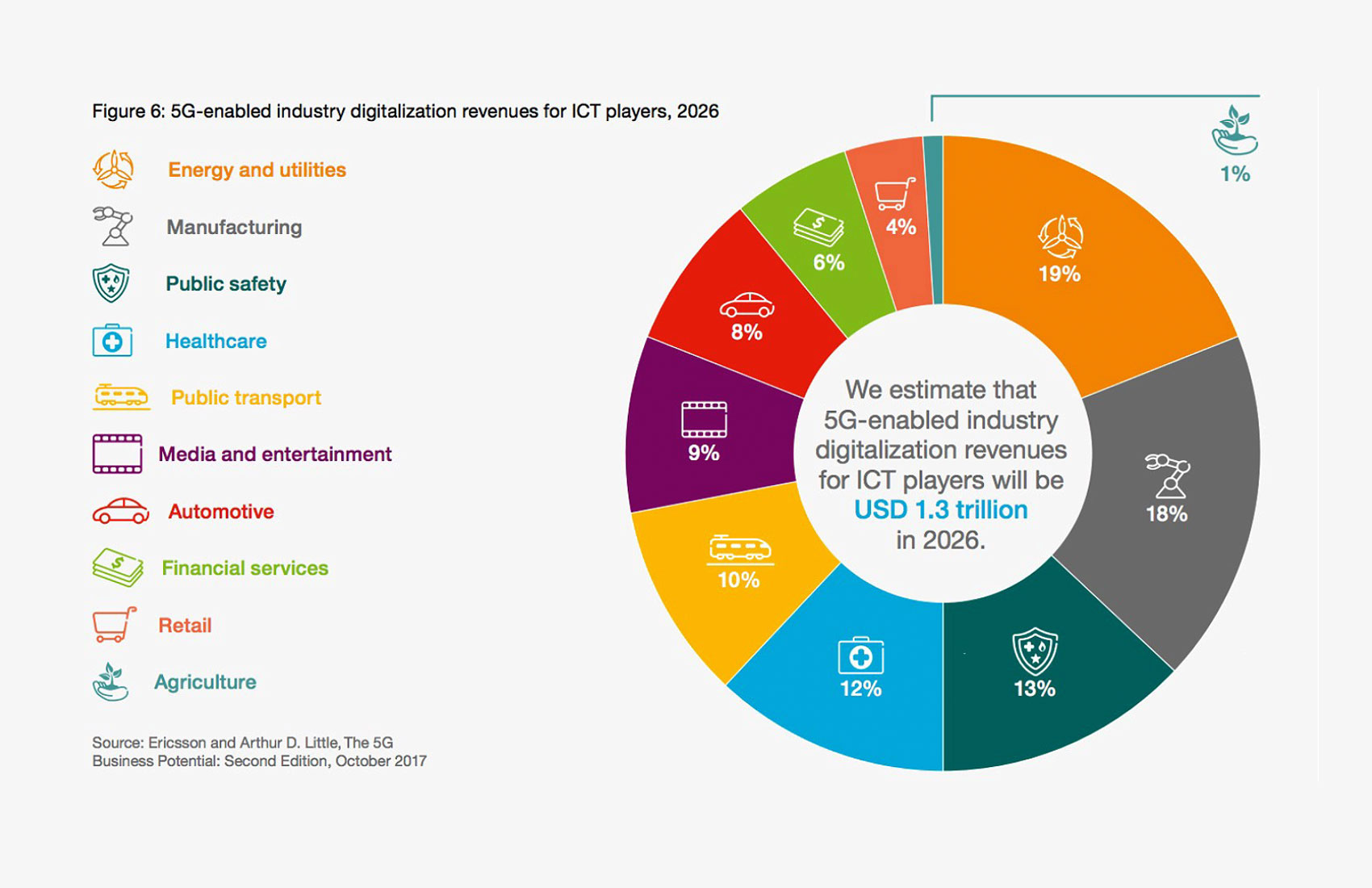As the major carriers have begun launching 5G trials in select markets, we’re catching a glimpse of the discrepancies between “the future is now!” glossy marketing copy and the business realities of deploying a network that is forecast to require US $1T of infrastructure investment to achieve its full capabilities (according to Greensills’ “Financing the Future of 5G” report). Few doubt the potential for 5G to fundamentally change mobile communications, but for many businesses outside of the “mobile carrier-communication equipment complex”, the path to realizing this potential is hazy. Looking at the previous deployments of LTE and 3G can provide us with some insight, but the different flavors of 5G will likely create a fair number of sidings, dead ends, and roundabouts in the path forward. The largest carriers and equipment vendors have much to gain from the deployment of 5G, and they’re prepared to weather the long roll out. However, for innovative businesses that see 5G as an opportunity to disrupt their own industry, yet lack the capitalization or patience of those firms, I’d like to offer some key considerations for designing transformative 5G systems in the face of rollout uncertainty.

First, let’s hit on the flavors I mentioned above. Much of the consumer-facing media portrays 5G as a monolithic product that will be “included” in mobile phones in the future, but the reality is that 5G is a family of services designed to meet the needs of specific, yet varied applications. There are more thorough descriptions of these different applications, but for the purposes of this article here is a brief explanation:
eMBB Enhanced Mobile Broadband
High speed connectivity to media rich endpoints (i.e. mobile phones and laptops).Provides higher throughput and lower latencies than currently available with LTE.
Part of the eMBB use case, FWA FixedWireless Access – last mile connectivity to homes and offices with high-speed up and down link throughput. Fixed wireless access represents a significant push into a market not well penetrated by LTE.
URLLC UltraReliable, LowLatency Communications
Enables very precise coordination between devices to enable high speed remote control and coordination of multiple devices. Vehicle to everything (V2X) is the most commonly cited application.
mMTC Massive Machine Type Communications
Enables low-throughput communications between low cost smart nodes at densities significantly higher than the LTECat-M1 or NB-IoT.
PLAYING THE STRATEGY GAME
Today, all signs points to major carriers launching eMBB first, with many players focusing on FWA applications. These are use cases for which a market already exists, though the consumers that need the added benefits of 5G represent a small fraction of the total mobile community. eMBB will enable existing applications such as video streaming and online gaming on mobile devices as well as home networks to run smoother and at higher fidelities.

It is expected that aficionados of those services will be the first to pony up to buy this new equipment, with broader adoption follow-ing slowly. The initial deployments will be in medium to large urban markets, which makes sense because it provides the highest density of customers, which means smaller investments in infrastructure are required to service the same number of 5G consumers.This is the same game plan we saw in the roll out of LTE. Depending on who you ask,LTE took between two and five years from the initial deployments to achieving cover-age parity with 3G. It remains to be seen if 5G will be faster or slower.
Imagining all of the benefits of 5G is easy once the system is fully deployed. But until then it may feel like 5G isn’t living up to its promise. This is partially due to a complex interrelated calculus between carriers, user equipment vendors, and end customers during rollout. Investing too much in new infrastructure can tie up significant capital if the user equipment and users aren’t ready to take advantage of it. Makers of user equipment are rightfully hesitant to spend the marketing dollars on a new product, if the carriers can’t provide the network to a sufficient number of customers.
It’s tempting to wait and see how this all plays out and determine how 5G fits into your product road map, once the system achieves scale. But this strategy will likely leave you in the dust of your competitors. Businesses with a clear understanding of the risks, challenges and opportunities afforded in the great 5G roll out will have the advantage; not just by being the first to market, but also by helping to drive the rollout path in their favor.
INNOVATING WITH A BLINDFOLD ON
While the path to 5G is still uncertain, the definition of what 5G can and can’t do is well defined. Release 15 of the 3GPP standard provides developers with some confidence that the products they are designing today will work with 5G when it is fully deployed. The near-term challenge will be to understand how these technical specifications will enable innovative solutions when its simply not possible to observe the real-world performance.
It’s true that the increased throughput of 5G gets most of the attention of the mainstream media, but novel capabilities of URLLC and mMTC are not just enabled by higher bandwidth, they’re enabled by a fundamentally different approach to mobile communications. This will underpin entirely new applications as businesses trust their highest-value, mission critical functions to the network. A solid understanding of how these standards differ from LTE is a good first step to reimagining products and services that will disrupt your market.
SEEING THROUGH THE BLINDFOLD
Businesses seeking to exploit the opportunity of 5G in order to get ahead of their competition will need to leverage detailed system models of communication protocol, as well as understanding how that protocol interacts with the rest of the system. The challenge will lie in making sure those models capture the true corner cases — those outside of normal operating parameters — in the system. The headline of low latencies within URLLC may hide the limitations of how critical data will need to be prioritized to meet the restricted bandwidth of the protocol. Determining how to set that threshold will involve understanding the relationships between incoming and outgoing data, down to the byte level. The nature of a high-reliability application (requiring high reliability because the consequences of failure are significant) means that any system modeling should be conducted with a similar level of care and detail.
Businesses looking to be the first to exploit the 5G opportunity will need to start designing their solutions well before the full system is deployed. For ambitious companies, direct partnerships with carriers, equipment vendors, and system integrators can provide a clear path to making sure that innovation arrives at the time the network is ready to support it.
Some levels of prototyping can also be leveraged using test equipment or hardware that can emulate the network performance. Again, the real challenge lies in ensuring that the emulation captures the conditions that determine the success or failure of your business-critical application.
Businesses looking to be the first to exploit the 5G opportunity will need to start designing their solutions well before the full system is deployed. For ambitious companies, direct partnerships with carriers, equipment vendors, and system integrators can provide a clear path to making sure that innovation arrives at the time the network is ready to support it.

For companies that have the ambition to lead 5G product innovation, but don’t have the market size or the financial backing, the slow deployment of 5G could be seen as an opportunity. The path to realizing that opportunity will require businesses to design solutions based on the specification early on and then to validate the performance when the required network features go live. For businesses outside of the mobile carrier and equipment vendor worlds, perhaps in the automotive, agriculture or logistics industries, there remains a problem of language and terminology. It’s vital that these businesses don’t let the language of the carrier obscure the opportunity for their industry or business, and in turn, the telecoms world must adjust how it communicates in order to convey the 5G opportunity to these new potential clients. Help is at hand, in the form of industry groups and development partners. A good example is in the automotive sector, which is embracing 5G and coordinating its approach to standardization through the 5G Automobile Association (5GAA), leading to it having a greater level of influence than many other sectors. Similarly, product development partners that are experienced in the telecoms world, as well as in developing products in diverse industries, can act as a bridge, ensuring a single coherent view of the opportunity.
Uncertainty in deployment plans may deter some market leaders from making the right R&D investments. This in turn opens a privileged window of opportunity for bold innovators that accept 5G technology as definitive and have a clear view of the applications that can transform their market.
